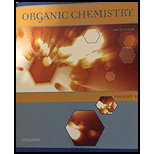
Interpretation:
4-Pyrone on treatment with acid gets protonated on the carbonyl group oxygen to yield a stable product. Why the structure is so stable is to be explained using resonance structures and the Huckel’s (4n+2) rule.
Concept introduction:
A compound to become
To explain:
Using resonance structures and the Huckel’s (4n+2) rule why the protonated product obtained when 4-pyrone reacts with acid is so stable.
Trending nowThis is a popular solution!

Chapter 15 Solutions
Organic Chemistry: Volume Ii, 9th Edition With Owlv2 Access Code
- What explains why many aldehydes and ketones can undergo self-condensation reactions in basic conditions? The alpha carbon can lose a proton and act like a nucleophile and the carbonyl carbon is an electrophile. The alpha carbon can gain a proton and act like an electrophile and the carbonyl carbon is a nucleophile. The oxygen of the carbonyl group can attack the carbon of the carbonyl group. Only esters can undergo self-condensation reactions.arrow_forwardProvide the correct product(s) for the following reactionarrow_forwardWhat is the source of the nucleophilic attack? How does the oxygen get protonated? What causes the elimination reaction?arrow_forward
- b) The Wolf-Kishner reduction is a reaction used in Organic Chemistry to convert carbonyl functionalities into methylene group. The reaction was used to convert an aldehyde or ketone to an alkane using hydrazine, base and thermal conditions. The mechanism begins with the attack of hydrazine of the aldehyde or ketone. Stage 1: The reaction of aldehyde/ketone with hydrazine to produce hydrazine Stage 2: Reaction with the base and heat to convert hydrozone to alkane Write the mechanism of the reaction.arrow_forwardGive the major product of the following reaction. 1) ВН3/THF 2) H202, NaOHarrow_forwardComplete the Explain what is 1 HBr (no peroxides) HBr peroxides H₂O, H* following reactions of allenes, happeningarrow_forward
- Provide a structure for the major products of the reactions and include the steps for each reaction.arrow_forwardExplain why pentane-2,4-dione forms two alkylation products (A and B) when the number ofequivalents of base is increased from one to two.arrow_forwardDraw the structure of the major organic product(s) of the reaction. -N H3O+arrow_forward
- 1) Nucleophilic substitution reaction of alkyl halide is a process when nucleophile replace the leaving group of alkyl halide. Propose the mechanism and product(s) for the following substitution reaction.arrow_forwardDraw a structure for the major organic product you would expect from reaction of 3-methyl-3-pentanol with NaH.arrow_forwardGive the major organic product of the following reaction. H2 Niarrow_forward
